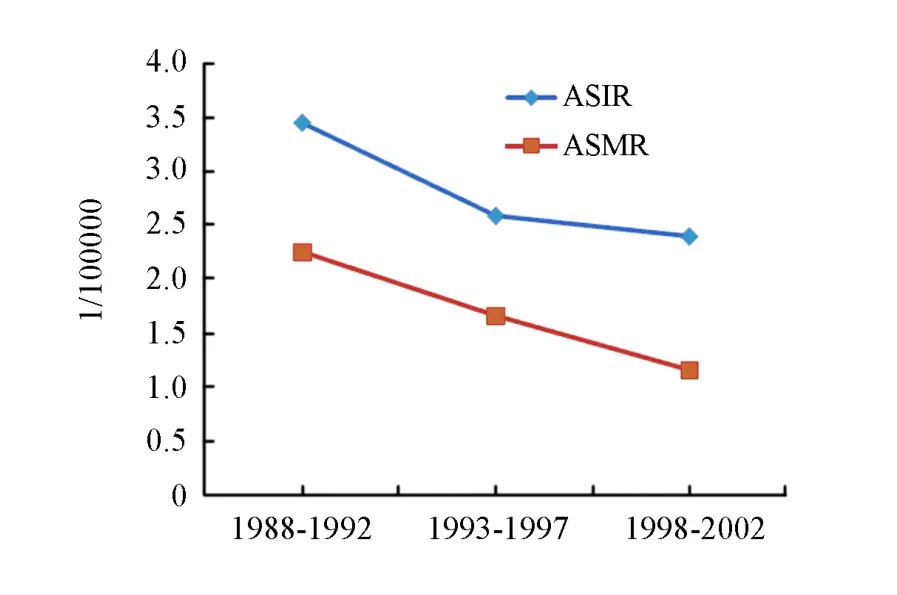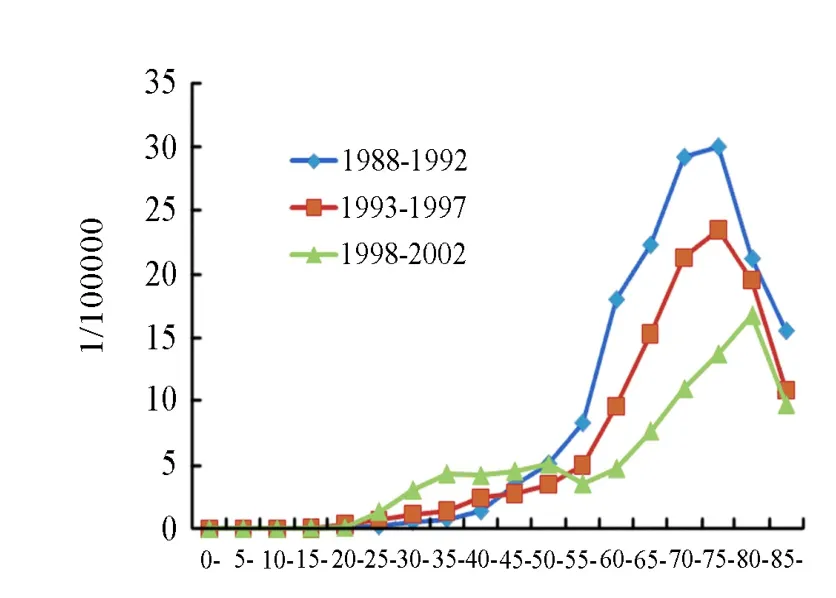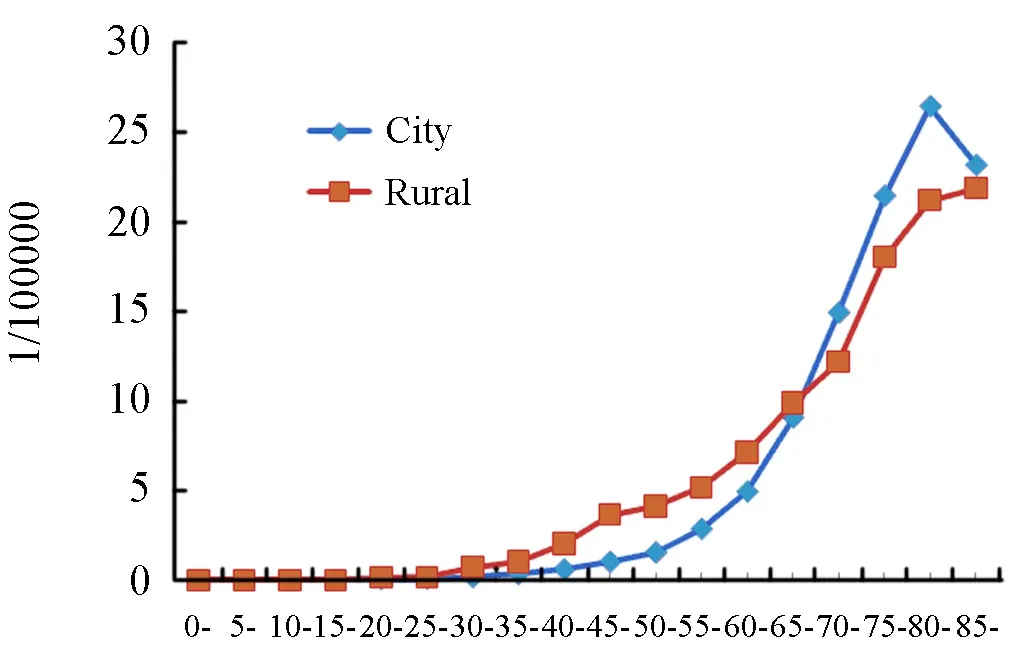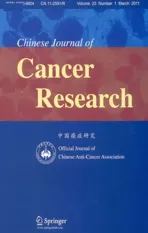Incidence And Mortality Trend of Cervical Cancer in 11 Cancer Registries of China
2011-08-02TaoLeiWeiminMaoTonghaiLeiLiqiongDaiLuoFangWanqingChenSiweiZhang
Tao Lei, Wei-min Mao*, Tong-hai Lei, Li-qiong Dai, Luo Fang,Wan-qing Chen, Si-wei Zhang
1The Zhejiang Cancer Hospital, Hangzhou 310022, China; 2Cancer Institute and Hospital, Chinese Academy of Medical Sciences, Peking Union Medical University, Beijing 100021, China
INTRODUCTION
Cervical cancer is a common malignant neoplasm of the cervix uteri in women.According to Globocan2002, the estimated incidence cases in the world was 493,243 with 83.0% of new cases in the less developed countries[1].In recent decades, the incidence rates of cervical cancer showed a decreasing trend in many countries[2-4].China, as a less developed country with huge population, the incidence and mortality rate of cervical cancer there was a decreasing trend in the period of 1970- 1990[5-6].In Qidong, China, a relatively low incidence area of cervical cancer, there was a decreasing trend of incidence rate among aged women during the period of 1972-2000, according to population-based cancer registration data[7].Due to the lack of valid data, the national analysis about cervical cancer prevalence was unavailable.
In 1996, the Ministry of Science and Technology of the People’s Republic of China set up a research program for national cancer registration, risk surveillance and risk Assessment.It was finished in 2000.It was the first time to establish a nation wide network of cancer registration in China.The cancer registries have followed the international rules and standards, therefore, the data collected on the incidence and mortality of cervical cancer in this system over the past 15 years have provided an opportunity to study the time trends of cervical cancer in China.
MATERIALS AND METHODS
Data Source
The cancer incidence and mortality data used in this study were based on a series of publications that included data from cancer registries in China for three periods of 1988-1992, 1993-1997, and 1998-2002.The related books were published in 2001, 2002 and 2007 respectively[8-10].
All cancer registries were population based and followed the rule and standard recommended by the International Agency for Research on Cancer (IARC) and the International Association for Cancer Registration.The details of methodology have been documented in the series publications by IARC[11-12].In this study, the periods and coding used were same as above.All data of each cancer registry were reported to the National Cancer Research and Control Office for quality assessment and data analysis.Data collected included population, incidence cases, and mortality cases by 5 years age group, sex and area.
For data consistence, this study selected data from 11 cancer registries that covered by all three volumes published by IARC.Those cancer registries included five cities, namely Beijing, Shanghai, Tianjin, Wuhan and Harbin, and seven counties, Cixian of Hebei province, Linzhou of Henan province, Qidong of Jiangsu province, Jiashan of Zhejiang province, Fusui of Guangxi province and Changle of Fujian province.For those 11 cancer registries, the analysis covered three periods, 15 years (1988-2002).
Population Data
For the 11 cancer registries during 1988-2002, the population covered 322,524,575 person-year, including 164,427,425 male (50.98%) and 158,097,150 female (49.02%),the sex ratio is 1.04; and 242,020,858 in cities (male:123,242,963, female: 118,777,895, sex ratio=1.04), rural areas 80,503,717 (male: 41,184,462, female: 39,319,255, sex ratio=1.05).Among those, 13.97% were over 60 years old(male 12.73%, Female 15.22%).
Data Analysis
The statistical indicators included crude rate (CR),age-adjusted rate by world population (WSR), age-adjusted rate by Chinese standard population (CASR), age-specific rate, 35-64 truncated rate (35-64TR), 0-64 cumulative rate(0-64CUMR) and 0-74 cumulative rate (0-74CUMR) for incidence as well as mortality by sex.The 1985 world standard population and the 2000 Chinese standard population were used for age adjusting.Statistical software package SPSS 13.0 was used.
RESULTS
Incidence and Mortality Rates of Cervical Cancer in China
During 1988-2002, a total of 6007 incidence cases and 3749 mortality cases of cervical cancer were reported in the 11 cancer registries.The incidence rate of cervical cancer was 3.80 per 100,000 for CR, 2.16 per 100,000 for CASR, 2.78 per 100,000 for WSR, 4.61 per 100,000 for 35-64 TR, 0.16% for 0-64 CUMR and 0.33% for 0-74 CUMR, respectively.In the same period, the mortality of cervical cancer was 2.37/100,000 for CR, 1.21/100,000 for CASR, 1.66/100000 for WSR, 1.97/100,000 for 35-64 TR, 0.07% for 0-64 CUMR and 0.19% for 0-74 CUMR (Table 1).
Trend of Incidence and Mortality Rates
In comparison between periods of 1988-1992 and 1998-2002, the incidence CR and WSR of cervical cancer decreased by 17.00% and 30.44% respectively; mortality CR and WSMR by 34.00% and 48.44% (Table 2 and Figure 1).

Table 1.Incidence and mortality rates of cervical cancer in the period of 1988-2002

Table 2.Incidence and mortality rates of cervical cancer in the period of 1988-2002
Age Specific Rates of Cervical Cancer
Cervical cancer was a typical aging disease with starting age from 15 and reached the peak at age group 75-79 and 5 years delay for mortality.Even though the ASIR and ASMR of cervical cancer showed a decreasing trend, the reversed changes were observed for women at middle age groups.In comparison between periods of 1988-1992 and 1993-1997,the age specific incidence rates showed an increase for age group under 45 years old and decreasing for 45 or old group.For those between periods of 1993-1997 and 1998-2002, the cut point was 55 years old.The mortality showed a similar trend as incidence (Table 3, Figures 2, 3).

Figure 1.Trend of incidence rate of cervical cancer in the period of 1988-2002.

Figure 2.Age specific incidence rate of ervical cancer by period

Figure 3.Age specific mortality rate of cervical cancer by period

Figure 4.Age-specific incidence rate of cervical cancer by area

F igure 5.Age-specific mortality rate of Cervical cancer by area

Figure 6.Trend comparison of incidence rate of cervical cancer among selected populations.

Table 3. Incidence and mortality rates of cervical cancer by age group (1/100,000)

Table 4.Incidence and mortality rates of cervical cancer by area (1/100,000)

Table 5.Comparison of incidence rate of cervical cancer for the period of 1988-2002
Difference between City and Rural Area
In comparison of the incidence of cervical cancer between city and rural area, the cervical cancer was 33%higher in urban than rural areas while and the mortality was slightly high (0.07%) in urban than rural areas (Table 1).
To compare it by age group, for age under 60, the age specific rates of cervical cancer for women in rural areas were higher than that in city, but lower for women at 60 or older (Table 4, Figure 4).A similar trend like incidence was observed for age specific mortality rates with an extended cut point at 70 or older (Table 4, Figure 5).
DISCUSSION
The data used in this study were based on 11 cancer registries which were collaborative partners of a national program for cancer registration in China, and provided the most reliable, the largest comparable sample size and the longest period data source in China.In addition, the data of 11 cancer registries were accepted by IARC.
As estimated the prevalence rate of cervical cancer in the world was 16.2 per 100,000 for incidence and 8.9 per 100,000 for mortality (10.3 per 100,000 and 6.4 per 100,000 in more developed countries; and 19.1 per 100,000 and 9.5 per 100,000 in less developed countries), respectively.We compared the incidence rates o cervical cancer in SEER program and Chinese of Los Angeles in the US, Osaka of Japan, Hongkong, China and Singapor Chinese, the rates of cervical cancer decreased worldwide including China, a country at a relative low level (Table 5 and Figure 6).
Table 5 shows a comparison among different populations including SEER program and Chinese of Los Angeles in the United States of America, Osaka of Japan,Hongkong and Singapore Chinese.The incidence rate of cervical cancer decreased worldwide including China, a country at lower level (Table 5 and Figure 6).
Although time trend of overall cervical cancer has been decreasing during the past 15 years, the rates of incidence or mortality have been increasing for young women.This study revealed a reversed trend in young women,particularly in rural area.It is very important for oncologist and health authorities to pay more attention to this phenomenon.
An early cervical cancer-screening program in a population of 22,106 women aged over 25 years in a rural county of China indicated that the relative risk of cervix cancer was 0.33 in women with three or more negative smear tests[13], supporting the cervical cancer screening is an efficient method for cervical cancer control[14,15].
It has been reported that the immigrants in the United States would change their cancer patterns and rates from original countries to that in the new country after certain years and generations[16,17].
A number of factors may be associated with the development of cervical cancer.The most important risk factor for cervical cancer is human papillomaviruse (HPV)infection.A case- control study was conducted in Hubei,China and reported that HPV DNA was detected in 94.55%of patients with cervical cancer, and 23.64% of control subjects[18].The risk of cervical cancer among women infected with HPV was 75.79 times greater than non-infected women.Due to the fact that the path of HPV infection is through sexual activities, resulting a constant increasing rates of sexual diseases and HPV infection during the same period of this study[19,20], we assume that the increasing trend of cervical cancer in young women who are sexual active may be associated with high epidemic of HPV.Further studies are needed to explore the possible reasons for the increased trend of cervical cancer and control cervical cancer in China.
In summary the incidence and mortality rates declined during the period of 1988-2002 in China, including urban and rural areas.When the data classified by age group, the declining trends only showed for older women.The younger women showed an increasing trend during the same period, especially for women in rural area.
1.Ferlay J, Bray F, Pisani P, et al.GLOBOCAN 2002: Cancer Incidence,Mortality and Prevalence Worldwide.Lyon: IARC Press; 2004.
2.Cornelison TL, Montz FJ, Bristow RE, et al.Decreased incidence of cervical cancer in medicare-eligible California women.Obstet Gynecol 2002; 100:79-86.
3.Howlett RI, Marrett LD, Innes MK, et al.Decreasing incidence of cervical adenocarcinoma in Ontario: is this related to improved endocervical Pap test sampling? Int J Cancer 2007; 120:362-7.
4.Chu J, White E.Decreasing incidence of invasive cervical cancer in young women.Am J Obstet Gynecol 1987; 157:1105-7.
5.Yang L, Huangpu XM, Zhang SW, et al.Changes of mortality rate for cervical cancer during 1970's and 1990's periods in China.Zhongguo Yi Xue Ke Xue Yuan Xue Bao (in Chinese) 2003; 25:386-90.
6.Li H, Jin S, Xu H, et al.The decline in the mortality rates of cervical cancer and a plausible explanation in Shandong, China.Int J Epidemiol 2000; 29:398-404.
7.Chen JG, Zhang YH, Zhu J, et al.Analysis on incidence for cervical cancer in Qidong during 1972-2000.Zhonghua Fu Chan Ke Za Zhi (in Chinese) 2004; 39:505-7.
8.Office TNCRaC, ed.Cancer incidence and mortality of cities/counties for pilot study in China (1988-1992).Beijing: Chinese Medical Science and Technology Press.2001.
9.Office TNCRaC, ed.Cancer Incidence and Mortality of cities/counties for pilot study in China (1993-1997).Beijing: Chinese Medical Science and Technology Press.2002.
10.Office TNCRaC, ed.Cancer Incidence and Mortality of Cities/Counties for Pilot Study in China (1998-2002).Beijing: People’s Medical Publication House; 2007.
11.Parkin DM, Whelan SL, Ferlay J, et al.Cancer Incidence in Five Continents.Vol.I to VIII.IARC Cancer Base No.VII.Lyon: IARC Press;2005.
12.Curado MP, Edwards B, Shin HR, et al.Cancer Incidence in Five Continents.Vol.IX.IARC Scientific Publications No.160.Lyon: IARC Press; 2007.
13.Zhang ZF, Parkin DM, Yu SZ, et al.Cervical screening attendance and its effectiveness in a rural population in China.Cancer Detect Prev 1989;13:337-42.
14.van der Aa MA, Pukkala E, Coebergh JW, et al.Mass screening programmes and trends in cervical cancer in Finland and the Netherlands.Int J Cancer 2008; 122:1854-8.
15.Jun JK, Choi KS, Jung KW, et al.Effectiveness of an organized cervical cancer screening program in Korea: results from a cohort study.Int J Cancer 2009; 124:188-93.
16.Stellman SD, Wang QS.Cancer mortality in Chinese immigrants to New York City.Comparison with Chinese in Tianjin and with United States-born whites.Cancer 1994; 73:1270-5.
17.Lee J, Demissie K, Lu SE, et al.Cancer incidence among Korean-American immigrants in the United States and native Koreans in South Korea.Cancer Control 2007; 14:78-85.
18.Cai HB, Ding XH, Zhou YF, et al.Risk factors for cervical cancer in China:a case-control study.Eur J Gynaecol Oncol 2008; 29:72-5.
19.Ruan Y, Qin G, Yin L, et al.Incidence of HIV, hepatitis C and hepatitis B viruses among injection drug users in southwestern China: a 3-year follow-up study.AIDS 2007; 8:S39-46.
20.Ruan Y, Jia Y, Zhang X, et al.Incidence of HIV-1, syphilis, hepatitis B, and hepatitis C virus infections and predictors associated with retention in a 12-month follow-up study among men who have sex with men in Beijing, China.J Acquir Immune Defic Syndr 2009; 52: 604-10.
杂志排行
Chinese Journal of Cancer Research的其它文章
- Elevated Circulating Levels of Osteopontin Are Associated with Metastasis in Advanced Non-Small Cell Lung Cancer
- Mobilization of Peripheral Blood Stem Cells Using Regimen Combining Docetaxel with Granulocyte Colony-stimulating Factor in Breast Cancer Patients
- Validation And Reliability of Distress Thermometer in Chinese Cancer Patients
- Correlation Between Hyaluronic Acid,Hyaluronic Acid Synthase And Human Renal Clear Cell Carcinoma
- Factors Affecting Mesenchymal Stromal Cells Yield from Bone Marrow Aspiration
- Reversion of Multidrug-Resistance by Proteasome Inhibitor Bortezomib in K562/DNR Cell Line
